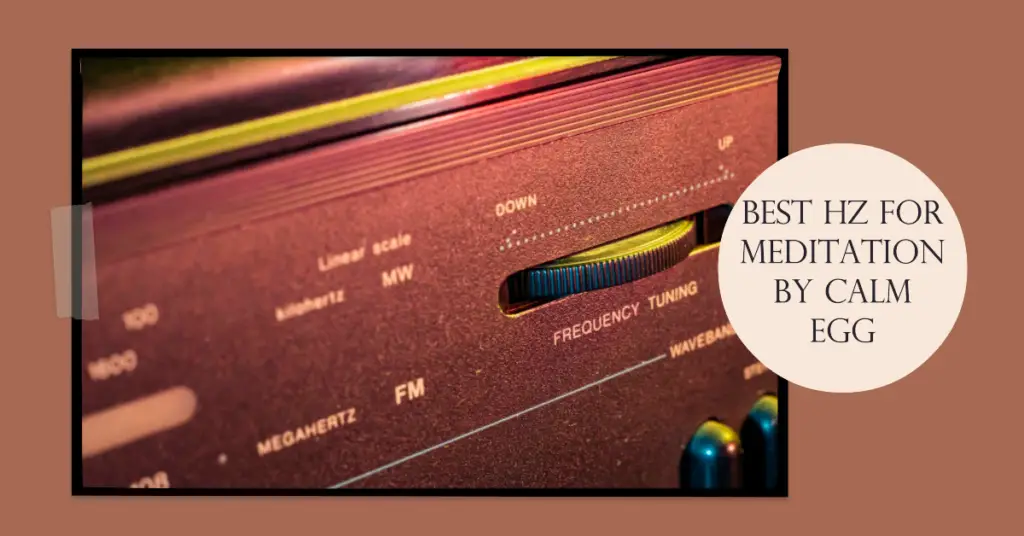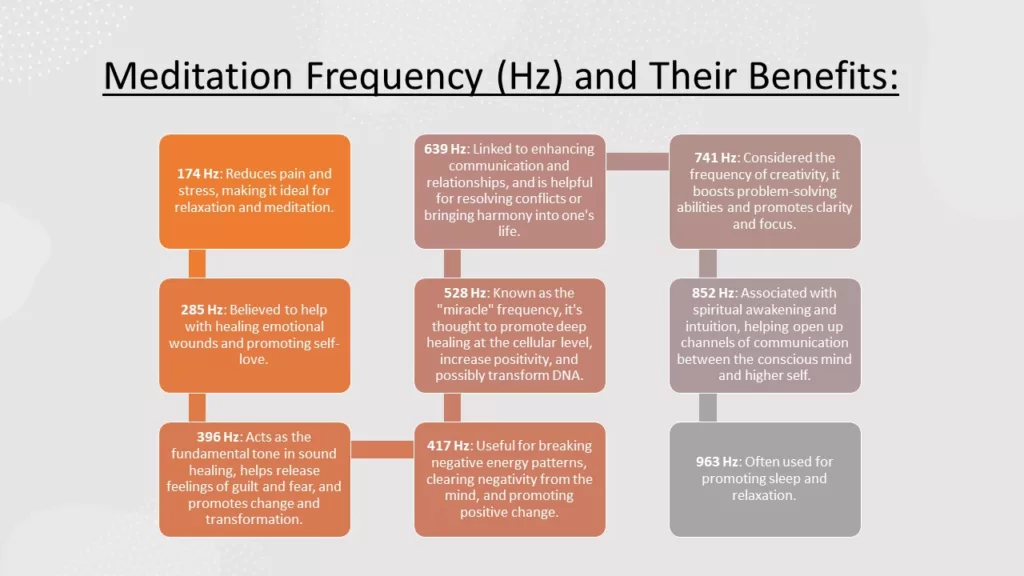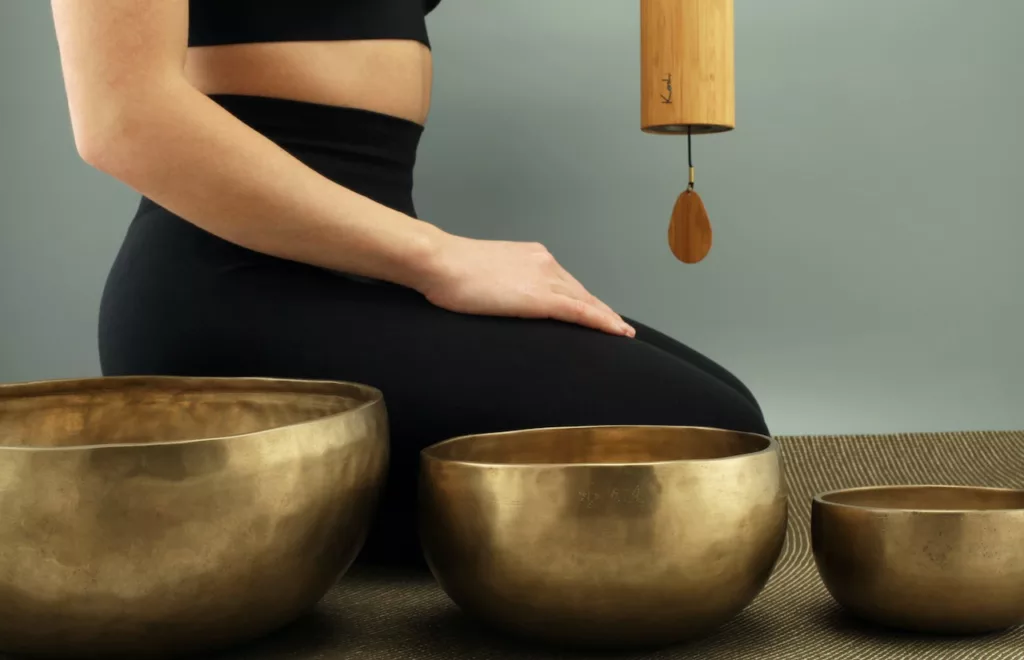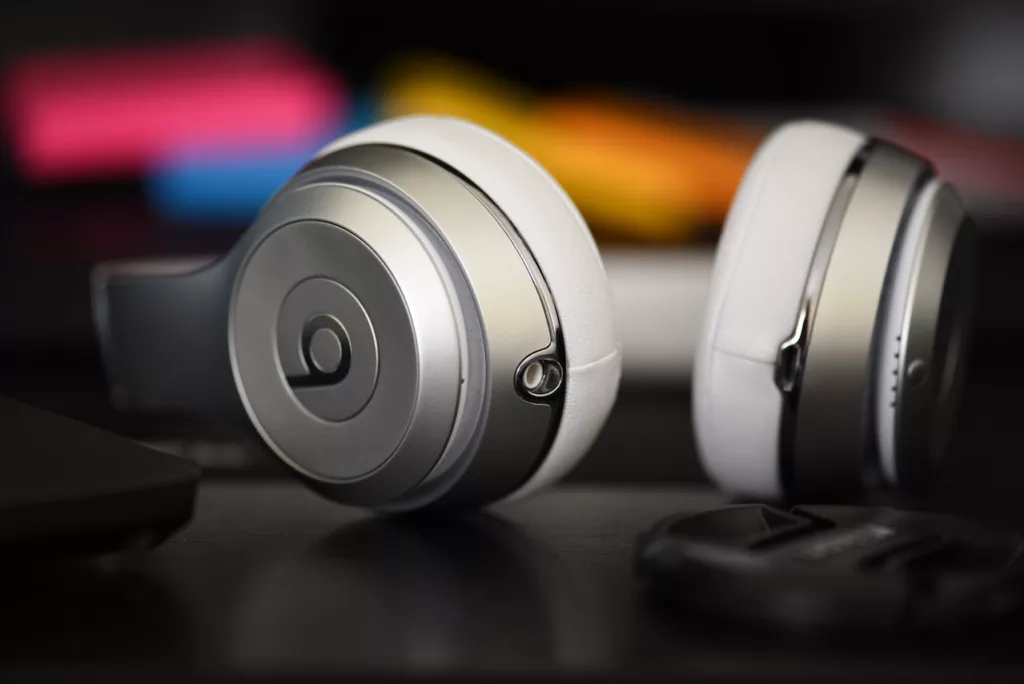Ultimate Guide to Meditation Frequencies: Finding Your Best Hz

Meditation is a transformative journey, and the right frequency can amplify its effects, guiding us to deeper states of consciousness and relaxation. Are you looking to elevate your meditation experience? Exploring the world of Hz frequencies could be your key.
These specific sound vibrations interact powerfully with our mind and body, enhancing the meditative state and potentially unlocking deeper layers of relaxation, healing, and self-discovery.
Dive into this comprehensive guide to understand various Hz frequencies proven effective for meditation and discover what are the best frequencies to meditate to.
The best Hz for meditation can vary depending on personal preferences and goals, but we recommend starting your day with 432 Hz for morning meditation, known as nature’s frequency, to promote a deep connection with the natural world and enhance overall well-being.

Key Takeaways
- Hz frequencies are specific sound vibrations that can affect the brain and body during meditation, leading to relaxation and clarity of mind.
- The ideal hertz frequency for meditating or experiencing lucid dreaming may vary from person to person, but some popular options include specific Solfeggio frequencies such as 528 Hz for transformation and deep healing or nature’s frequency at 432 Hz.
- Incorporating these frequencies into your meditation practice can enhance its benefits significantly by reducing stress and anxiety, promoting relaxation and sleep, increasing intuition, creativity, and even pain relief.
- While binaural beats can be a great tool for enhancing meditation practice potential health benefits, they should not be used as a replacement for medical treatment or professional therapy.
Understanding Hz Frequencies And Their Effects On The Mind And Body During Meditative State

Hz frequencies are specific sound vibrations that can affect the brain and body during meditation, leading to relaxation and clarity of mind.
What Are Hz Frequencies?
Hz frequencies, short for Hertz frequencies, are measurements of sound waves that indicate the number of cycles per second. In simple terms, they represent the pitch or tone of a particular sound.
In the world of meditation and relaxation, specific Hz frequencies have gained attention due to their potential impact on our mind and body. For example, it’s believed that listening to certain tones can help stimulate brainwave activity associated with relaxation states like alpha waves (8-12 Hz) or theta waves (4-7 Hz).
These types of rhythms have been shown to promote deep restorative sleep or even induce lucid dreaming experiences in some cases.
How Do They Affect The Brain And Body During Meditation?
Hz frequencies have a profound impact on the mind and body during meditation. When listening to certain frequencies, our brain begins to synchronize with them through a process called brainwave entrainment.
For example, the 528 Hz frequency is believed to resonate with the heart chakra and promote transformational healing while reducing negative emotions such as fear and anxiety.
On the other hand, 432 Hz is known for its calming effect on the mind similar to nature sounds like birds chirping or ocean waves crashing.
In short, by using specific Hz frequencies during your meditation practice, you can achieve different goals tailored to your unique needs.
Benefits Of Music Based On Hz Frequencies
Music based on Hz frequencies can have a profound impact on your meditation experience, from reducing anxiety and stress to promoting relaxation and deep sleep.
The 5 Most Common Meditation Frequencies
Meditation can be enhanced with specific sound frequencies that can help raise positive energy. Here are the 5 most common meditation frequencies you should know about:
| Frequency (Hz) | Description |
|---|---|
| 528 Hz | Known for its transformative and deep healing qualities. Excellent for those looking to heal past traumas or emotional blockages. |
| 432 Hz | Also known as nature’s frequency. Believed to promote harmony with the earth and nature, helping to calm the mind and reduce stress levels. |
| 639 Hz | Great for enhancing communication and relationships. Said to improve interpersonal connections and promote empathy between individuals. |
| 741 Hz | Beneficial for those in need of a creativity boost or improved problem-solving skills. Promotes inspiration and creative thinking. |
| 963 Hz | Often used for sleep and relaxation. Believed to have calming effects on the mind and body, making it ideal for bedtime meditation or yoga practices. |
By experimenting with different frequencies based on your meditation goals, you can find the perfect tone that resonates with you and enhances your practice even further.
The 9 Solfeggio Frequencies And Their Benefits – The Solfeggio Tone
The Solfeggio frequencies are a set of nine different sound frequencies, originally used in Gregorian chants, with various benefits for the mind and body. Here is a breakdown of each frequency and its associated benefits:

Incorporating these frequencies into your meditation practice can enhance its benefits significantly. Experiment with different frequencies to find what works best for you based on your goals or intentions for meditation.
Recommending the Best Frequencies for Meditation
When it comes to choosing the best frequencies for meditation, it’s important to consider your specific needs and the time of day you prefer to meditate. Here are our recommendations for the best frequencies based on different meditation sessions:
Best Hz for Morning Meditation:
Start your day with clarity and focus by meditating to 432 Hz, also known as nature’s frequency. This frequency is believed to promote a deep connection with the natural world and enhance your overall sense of well-being.
Best Hz for Afternoon Meditation:
For an afternoon pick-me-up and increased creativity, try meditating to 741 Hz. This frequency is associated with boosting problem-solving abilities and stimulating your creative flow, making it perfect for an energizing afternoon meditation session.
Best Hz for Late Night Meditation:
When winding down for the night, consider meditating to the calming frequencies of 528 Hz. This transformative and deeply healing frequency can help release negative emotions, reduce stress levels, and promote physical and emotional healing, preparing you for a restful night’s sleep.
Best Hz for Customized Meditation:
Every individual is unique, and what works for one person may not work for another. If none of the recommended frequencies resonate with you, explore different frequencies and find the one that brings you the most peace and relaxation during your meditation practice.
Remember to use headphones for a more immersive experience when listening to the frequencies.
Important Note: While these frequencies can be beneficial for enhancing your meditation practice, they should not be used as a substitute for medical treatment or professional therapy.
Top Hz Frequencies For Meditation – Which Frequency is good for meditation ?

The ideal hertz frequency for meditating or experiencing lucid dreaming is highly personal, but some frequencies are known to have specific benefits. Learn about the benefits of 528 Hz for transformation and deep healing, 432 Hz as nature’s frequency, 639 Hz for enhancing communication and relationships, 741 Hz for boosting creativity and problem-solving, and 963 Hz for sleep and relaxation.
The Ideal Hertz Frequency For Meditating Or Experiencing Lucid Dreaming
Finding the ideal hertz frequency for meditation or lucid dreaming can be a personal and subjective experience. However, many people find that frequencies in the range of 4 to 8 Hz, known as theta waves, are useful for achieving deep meditative states and even lucid dreaming.
For those looking to enhance their meditation or achieve lucid dreams, experimenting with different frequencies may be helpful. Some popular options include specific Solfeggio frequencies such as 528 Hz for transformation and deep healing or nature’s frequency at 432 Hz.
The Benefits Of 528 Hz For Transformation And Deep Healing
One of the most popular Hz frequencies used in meditation is 528Hz. This frequency is known to have transformative and deep healing properties that can positively impact the mind and body.
When listening to 528Hz music during meditation, it can help you release negative emotions, reduce stress levels, and promote physical and emotional healing.
Numerous studies have shown that exposure to this frequency can produce beneficial effects such as reducing anxiety, improving cognitive function, lowering blood pressure levels, enhancing mood, and even promoting DNA repair.
The Benefits Of 432 Hz, Known As Nature’s Frequency
Another popular frequency for meditation is 432 Hz, which is referred to as nature’s frequency. This frequency has been linked to a sense of calm and relaxation, making it an ideal choice for those looking to reduce anxiety or stress during their meditation practice.
In addition to its calming benefits, some practitioners believe that listening to music based on 432 Hz can also lead to a deeper spiritual connection and even aid in emotional healing.
Many people report feeling more uplifted after meditating with this frequency, making it a great option for those seeking an extra boost of positivity during their practice.
The Benefits Of 639 Hz For Enhancing Communication And Relationships
The 639 Hz frequency is commonly used to enhance communication and relationships. When this frequency is played during meditation, it can help individuals connect better with others by promoting empathy, understanding, and compassion.
Studies have shown that listening to 639 Hz music for at least an hour a day aids in balancing the Throat Chakra which governs communication. Anyone who struggles with social anxiety or shyness may benefit from using this frequency too.
In conclusion, adding 639 Hz frequencies to your daily meditation practice could do wonders in enhancing communication and improving your relationships both personal or professional.
The Benefits Of 741 Hz For Boosting Creativity And Problem-solving
Another frequency worth exploring for meditation is 741 Hz. This frequency helps to stimulate problem-solving and creativity and has been used by renowned artists, writers, and musicians alike.
In fact, Mozart was said to have composed his music in the 741 Hz range.
Research also suggests that the 741 Hz frequency can help boost serotonin levels in the body which plays a significant role in regulating mood, appetite, digestion as well as improving overall cognitive function.
The Benefits Of 963 Hz For Sleep And Relaxation
Another powerful frequency for relaxation and sleep is 963 Hz. This Solfeggio frequency is associated with the Crown Chakra, which governs spiritual connection and enlightenment.
It has been proven to help reduce stress levels while promoting a sense of calmness, making it ideal for those who struggle with anxiety or insomnia.
Many people have experienced profound benefits from using 963 Hz frequencies during meditation or before bed. One anecdote is that some individuals report having dreamless sleep after using the 963 Hz tone as part of their bedtime routine.
How To Choose The Right Hz To Meditate

To choose the right Hz frequency for your meditation practice, first understand your goals and experiment with different frequencies until you find one that resonates with you.
Understand Your Meditation Goals
Before choosing the right Hz frequency for your meditation practice, it’s essential to understand your goals.
For instance, suppose stress relief is one of your main goals. In that case, frequencies like 396 Hz or 528 Hz can provide excellent benefits such as calming effects and emotional release.
On the other hand, if enhancing intuition is what you seek, the 852 Hz frequency can stimulate spiritual awareness and awaken inner strength.
Experiment With Different Frequencies
As you explore different Hz frequencies for meditation, it’s important to take an experimental approach. Everyone’s body and mind respond differently to specific frequencies, so what may work well for one person might not work as effectively for another.
On the first attempt with a new frequency, pay close attention to how your body and mind respond.
It’s also worth noting that some people prefer listening to a mix of different frequencies during their meditation practice instead of just focusing on one.
Experimentation is key here- try mixing up various frequencies and see how they make you feel. Remember always to use high-quality headphones or speakers when experimentating.
Choose A Frequency That Resonates With You
Choosing the right Hz frequency for your meditation practice is crucial to achieving a deeper state of relaxation and focus. While there are specific frequencies that have been shown to offer particular benefits, ultimately, you should choose one that resonates with you.
For example, if you’re seeking deep healing or transformation in all areas of your life, 528 Hz may be the perfect choice for you. Conversely, if nature helps calm and center you, then 432 Hz might be more suitable.
Experimenting with different frequencies can help determine which ones work best for you as an individual.
Tips For Enhancing Your Meditation Practice With Hz Solfeggio Frequency
– Use high-quality headphones or speakers to fully immerse yourself in the frequency.
– Create a personalized Hz playlist that resonates with you and your meditation goals.
– Experiment with different frequencies to discover what works best for you.
– Combine Hz frequencies with other relaxation techniques such as deep breathing, yoga, or mindfulness meditation for maximum benefits.
– Set aside dedicated time for your meditation practice and make it a daily habit.
– Trust your intuition and let the sound frequencies guide you into a deeper state of relaxation and inner peace.
Using High-quality Headphones Or Speakers

Investing in high-quality headphones or speakers is an excellent way to enhance your meditation music experience with Hz frequencies. The right equipment can make a substantial difference in the sound quality, making it easier to focus on the rhythms and tones of the music.
Moreover, using high-quality headphones or speakers ensures that you get maximum benefits from your Hz frequencies playlist since they reproduce sound accurately without compromising its quality.
This means that there will be no missing parts of the tone or changes in pitch that could detract from the overall experience.
Creating A Personalized Hz Playlist
Personalizing your Hz playlist can greatly enhance your meditation practice. Here are some steps to help you create a playlist tailored to your needs:
- Identify the purpose of your meditation: Think about why you meditate and what you hope to achieve from it. Do you want to feel more relaxed, boost creativity, or improve sleep quality? This will help you choose the right frequencies for your playlist.
- Research Hz frequencies: Look up the benefits of different Hz frequencies and choose the ones that align with your goals.
- Experiment with different combinations: Try mixing different frequencies together and see how they make you feel. You may find that certain combinations work better for you than others.
- Choose high-quality recordings: Make sure to use high-quality recordings that are specifically designed for meditation.
- Set an intention: Before you start meditating, set an intention for what you want to achieve from the session and focus on that throughout.
By creating a personalized Hz playlist, you can tailor your deep meditation experience to your individual needs and goals. Whether it’s relaxation, stress relief, or improved creativity, there is a frequency out there that can help enhance your practice.
Combining Hz Frequencies With Other Relaxation Techniques
Incorporating sound frequencies into your meditation practice can be incredibly powerful, especially when combined with other relaxation techniques. Here are some tips for combining Hz frequencies with other relaxation techniques:
- Mindfulness meditation: Use Hz frequencies to help deepen your mindfulness practice by focusing on the sounds and vibrations of the frequency.
- Chakra balancing: Combine different Hz frequencies with chakra balancing exercises to enhance the cleansing and balancing effects.
- Sound healing: Use the Hz frequency that resonates with you during sound healing sessions or combine different frequencies to address specific areas of energy blockages in your body.
- Yoga Nidra: Incorporate Hz frequencies into your Yoga Nidra practice to amplify the relaxation and deep meditative state.
- Guided meditation: Listen to guided meditations that include specific Hz frequencies to enhance their effects on your mind and body.
Combining Hz frequencies with other relaxation techniques can result in a more profound experience. Experiment and find what works best for you based on your meditation goals, such as reducing anxiety, improving focus or enhancing sleep quality. Remember, choosing the right Hz frequency is personal, so find one that resonates with you and provides optimal benefits for your individual needs.
Exploring the Power of Specific Sound Frequencies in Meditation
In the world of meditation, specific sound frequencies have been utilized since ancient times to enhance the practice and promote relaxation and self-discovery. Understanding the power of these frequencies and incorporating them into your meditation practice can have profound effects on your mental and physical well-being.
Brain Wave Entrainement
One of the most powerful tools in utilizing sound frequencies for meditation is brainwave entrainment. This process involves exposing the brain to specific Hz frequencies, helping to synchronize brainwave activity with external stimuli. By listening to sounds with specific frequencies, our brainwaves naturally begin to align with these frequencies, inducing and enhancing desired states of relaxation and meditation.
For instance, the frequency of 432 Hz, also known as the natural frequency, has been used for centuries to promote a sense of harmony and tranquility. It is believed that this frequency resonates with the natural world, similar to the sounds of birds chirping or ocean waves crashing. By incorporating 432 Hz into your meditation practice, you can create a deeper connection with nature and experience a profound sense of calm and relaxation.
Additionally, specific frequencies such as 528 Hz, known as the frequency of transformation and deep healing, can help release negative emotions, reduce stress levels, and promote physical and emotional healing. This frequency is believed to have a positive impact on our DNA, transforming it at a cellular level and increasing positivity in our lives.
Binaural Beats

The use of binaural beats, which involve playing slightly different frequencies in each ear, can also enhance your meditation experience. These beats create a third frequency that your brain can tune into, leading to a state of deep relaxation and focus. Binaural beats have been shown to promote alpha waves (8-12 Hz) and theta waves (4-7 Hz), which are associated with relaxation and meditative states. By incorporating binaural beats into your meditation practice, you can achieve a deeper level of relaxation and concentration.
By exploring and harnessing the power of specific sound frequencies in your meditation practice, you can tap into the full potential of your mind and body. Utilizing frequencies such as 432 Hz and 528 Hz, as well as incorporating binaural beats, can help reduce anxiety, promote relaxation, and increase creativity and intuition. By experimenting with different frequencies and finding the ones that resonate with you, you can enhance your meditation experience and unlock a deeper sense of peace and self-discovery.
Overall, the use of specific sound frequencies in meditation can have profound effects on our mental and physical well-being. By incorporating these frequencies into your meditation practice, you can tap into the power of brainwave entrainment, promote relaxation and healing, and deepen your meditation experience. Whether it’s the natural frequency of 432 Hz or the transformative qualities of 528 Hz (Listening to this frequency is good for meditation), these specific sound frequencies can help you relax, reduce stress, and enhance your overall well-being.
Real Experiences: Testimonials on Meditation Frequencies
Hearing firsthand from individuals who’ve delved into the world of meditation frequencies can provide invaluable insights. Here are some testimonials from our community members:
🌟 Anna L., Yoga Instructor:
“I’ve always been skeptical about the power of specific frequencies in meditation. However, after consistently meditating with the 528 Hz frequency, I felt a profound shift. My meditation sessions became deeper, and I felt a sense of calm that lasted throughout the day. It’s now an integral part of my daily routine.”
🌟 Raj K., Software Engineer:
“Balancing work and personal life is challenging. I started using 432 Hz, known as nature’s frequency, during my evening meditation. It not only helped me relax but also improved my sleep quality. I wake up refreshed and more focused now.”
🌟 Mia S., Student:
“Meditation was always hard for me; my mind kept wandering. A friend suggested trying the 639 Hz frequency for better concentration. To my surprise, it worked wonders! My sessions became more focused, and I felt a deeper connection during meditation.”
These testimonials attest to the transformative power of specific Hz frequencies. As with any practice, it’s essential to find what resonates with you personally. Experiment with different frequencies and discover the unique rhythm that enhances your meditation journey.
Do Binaural Beats Have Health Benefits? Benefits of Solfeggio
Binaural beats are becoming increasingly popular in the world of meditation, but do they really have health benefits? The answer is yes! Binaural beats work by using different frequencies in each ear to create a third frequency that your brain can tune into.
The theta range (4-8 Hz) is particularly effective for binaural beats. This range is linked to REM sleep, meditative states, and creative thinking. By listening to binaural beats in this range during meditation, you may be able to reach deeper levels of relaxation and concentration.
It’s important to note that while binaural beats can be a great tool for enhancing your meditation practice and potentially improving your overall health, they should not be used as a replacement for medical treatment or professional therapy.
FAQs on The Best HZ For Meditation
1. What’s the best frequency for meditation?
The best frequency for meditation varies from person to person. However, many people find that frequencies between 10Hz and 40Hz are best for meditation. These frequencies are associated with alpha, theta, and delta brainwaves which are associated with relaxation and meditative states.
2. What is an HZ in meditation?
hz stands for Hertz and it refers to the frequency of sound waves. When used for meditation, hertz refers to the frequency of binaural beats or solfeggio frequencies that are used to induce a meditative state.
3. What are binaural beats?
Binaural beats are sounds that are created by playing two different frequencies in each ear. The difference between the two frequencies creates a third frequency that the brain experiences as a beat. This beat can help to entrain the brainwaves and induce a meditative state.
4. What are solfeggio frequencies?
Solfeggio frequencies are a set of frequencies that are believed to have specific healing properties. The frequencies include 396 Hz, 417 Hz, 528 Hz, 639 Hz, 741 Hz, and 852 Hz. Each frequency is said to have a specific effect on the mind and body.
5. Can sound frequencies help with relaxation?
Yes, sound frequencies can help with relaxation. Specific frequencies such as 639 Hz and 417 Hz are said to help with relaxation and reducing anxiety.
6. What is the effect of different frequencies on the brain?
Different frequencies have different effects on the brain. Low frequencies such as delta waves (0.1 Hz – 4Hz) are associated with deep sleep while higher frequencies such as beta waves (16Hz – 31Hz) are associated with alertness and concentration.
7. Can listening to solfeggio frequencies have a profound effect on the mind and body?
Some people believe that listening to solfeggio frequencies can have a profound effect on the mind and body. These frequencies are said to help with relaxation, healing, and balancing the chakras.
8. How can I use binaural beats for meditation?
You can use binaural beats for meditation by listening to them with headphones while in a comfortable position. Focus on your breath and allow the beats to entrain your brain
Conclusion: The Benefits Of Using Hz Healing Frequencies In Your Meditation Practice.
In conclusion, incorporating Hz frequencies into your meditation practice can have a significant impact on your mind and body. The ideal hertz frequency for meditation may vary from person to person, but experimenting with different frequencies can lead to finding one that resonates with you and enhances your meditation experience.
Whether it’s using music based on the Solfeggio frequencies or binaural beats in the theta range, utilizing specific sound frequencies has numerous mental and physical health benefits. It has been linked to reducing stress and anxiety, promoting relaxation and sleep, increasing intuition, creativity, and even pain relief.






